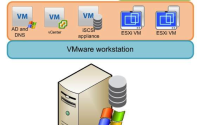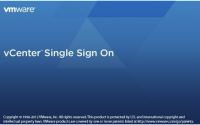VMware Interview Questions
Below are some of the questions to be prepared for when facing an interview about VMware, more to follow.
What are the main differences between Vsphere 4.x and 5.x?
| vSphere 4.X | vSphere 5.X |
| Have both ESX and ESXi | No ESX server any more |
| Service console comes with ESX( called as Console operating system) | No ESX , so no Service Console |
| Only windows based vCenter available | vCenter is now available as windows installation and also linux based appliance |
| Only vSphere client | Introduced Webclient to connect to vCenter, introduced sso and inventory services as well |
| Update manager can be used to patch guest operating systems as well | Update manager can only be used to patch ESXi servers, Virtual machines hardware, not support for guest OS available. |
What are the Fault Tolerance requirements and limitations for both VM’s and ESXi server?
VMware Fault Tolerance is a vSphere component which provides continuous availability to applications by preventing downtime and data loss of Virtual machines in the event of ESX server failure. Fault tolerance uses vLockstep technology.
ESX Host – Requirements and Limitations for FT.
1. VMware FT is only available in advanced, enterprise and enterprise plus licensing versions only
2. Enable hardware Virtualization in the BIOS
3. CPU compatibility have to be checked. Please refer vSphere documentation for CPU compatibility list.
4. Shared storage should be used to place FT VM’s ( Fiber channel, ISCSI,NFS)
5. FT virtual machines are to be placed in HA cluster only
6. DRS with FT is not supported in 4.0, but supported from 4.1 to latest 5.X versions.
7. Just 4 FT VM’s are allowed per ESX/ESXI server.
8. Make sure FT is enabled on the VMkernal port.
9. 10 gig nic card is preferred for replication between primary and secondary VM’s
10. 8100 and 8200 (outgoing, Incoming and outgoing UDP ports are used by FT, make sure these are open.
11. As FT works with HA , minimum of 2 hosts are required.
12. Microsoft clustering is not supported by FT.
13. Svmotion cannot be used to migrate a FT VM
Virtual Machines –Requirements and Limitation for Fault Tolerance
1. RDM in physical mode is not supported for FT VM, but Virtual mode RDM is supported.
2. FT VM’s should have eagerzeroed thick disks only. Even if you enable FT on thin provision disks, FT converts them to thick disk.
3. Only 1 vCpu per FT protected VM is allowed. SMP is not supported.
4. RAM limitation is 64 GB
5. Hot add and hot remove is not supported on FT 8.NPIV is not supported for FT VM’s.
6. VMDirect path and USB passthrough is not supported for FT VM’s
7. Snapshots are not supported, and hardware versions for VM should be 7 and above.
8. FT Protected virtual machines should not be HA disabled by Virtual Machine level HA settings.
What are Vmotion- Pre-requisites, Limitations and underlying Process?
VMotion: VMotion is a vSphere feature using which we can migrate a running VM from one host to other host, this is also referred as Live migration and also hot migration.
VMotion is used by DRS to load balance the cluster, by DPM and also it can be sued while taking a host in to maintenance mode.
Pre-Requisites:
- VMotion should be enabled on the VMkernal ports
- Recommended to have a dedicated 1gig or 10 gig Nic card.
- All hosts should have compatible CPU’s
- License for VMotion.
- ESX servers should have same network label name.
- Shared storage (FT, ISCSI, NFS)
Limitation:
- VMotion fails for VM’s on which CD rom is connected.
- Swap file location on the source and destination should be the same.
- VMotion will not work with Affinity rules in place.
Underlying process for VMotion.
For VM-1 being migrated from ESX-A to ESX-B, below are the steps involved.
- VMotion used bitmap process
- Memory of VM being migrated will be pre-copied from ESX-A to ESX-B, any memory changes during this process will be written to memory bitmap on ESX-A
- Using quiescing technology VM-1 will be quiesced, while the bitmap memory will be moved to ESX-B, from now all the tasks will be done on ESX-B.
- After successful migration the VM will be unregistered from ESX-A
What are the major differences between ESX and ESXi?
| Capability | ESX | ESXi |
| Service Console | Yes | Removed |
| Troubleshooting performed via | Service console | Shell |
| Management Network |
Service console |
VMkernal |
| Jumbo Frames | Supported | supported |
| Boot from SAN | Supported | Supported |
| Hardware monitoring | Third party agents | CIM |
| Patches | More as like Linux | Less as the footprint is very less |
| Lockdown mode | Not Present | Present |
| Command line | ESXCFG | ESXCLi |
| VMkernal network | vMotion, Storage and FT | Management Network, vMotion, FT, Storage, ISCSI port Binding. |


